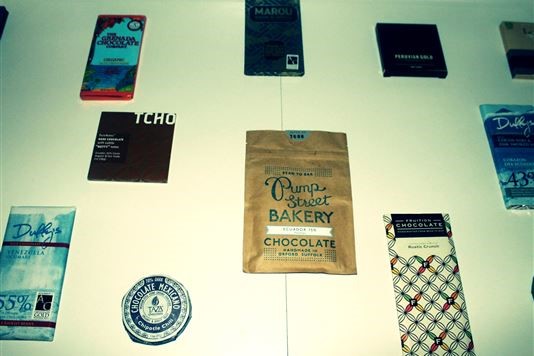
There’s a chocolate revolution coming. We sent chocaholic Elizabeth Ryan to a tasting event to learn more.
A chocolate revolution

I recently attended one of their tasting sessions and, an apparent novice, I admitted to the organisers that I considered a Hotel Chocolat Caramel Baton to be artisan. For me, the experience was akin to being led down the rabbit hole, and I don’t think I’ll ever look at a bar of Dairy Milk the same way again.
Eating E-numbers
Most commercial chocolate contains a minuscule amount of cocoa solids, around 20-30%, and adds a fat-load of milk, sugar, vegetable fat and E-numbers for flavouring. Artisan chocolate will consist primarily of cocoa solids, cocoa butter, sugar, lecithin (which makes it easier to work with) and vanilla, although those last two ingredients will account for less than 5%. There are currently around 15 varieties of cocoa beans around the world, and a dozen factors which influence their taste, including: the region they’re grown in; how and when they are harvested; and even how long they are left to rest.
Back in the tasting room, we were given an insight into how the chocolate tasters evaluate each bar – the vital thing to remember is to use all of your senses.
Sight
Firstly, sight. How is the colour, the consistency and the shine? The colour should be even and chocolate should never be black, as this indicates burnt beans. If there are little white spots that appear on the surface after chocolate is left in the heat, which is known as blooming, then the cocoa butter has risen to the surface and compromised the taste of the chocolate.
Sound
Then there’s sound. You need to listen to the chocolate and, no, I don’t mean when you hear its siren call of “eat me, eat me”! If chocolate has been tempered (brought to a certain hardness and strength) properly then it should give a satisfying snap when broken.
Feel
Next you should feel the chocolate. Is it smooth? If you rub good quality chocolate between your fingers it should be reduced to cocoa powder, but if you do the same with cheap chocolate it will leave you with a sticky, greasy mess.
Smell
Very importantly, and something that had never occurred to me before, is the smell of the chocolate. Cheap chocolate will smell of either nothing, sugar, or fake vanilla (vanillin). Artisan chocolate should give a hint of its flavour notes. Once you give a bar of artisan chocolate a good whiff you’ll be amazed that chocolate can smell quite so… chocolatey.
Taste
Finally, you pop the chocolate into your mouth to judge the taste. You shouldn’t chew it to begin with, as this changes the way that the flavour notes are released. Instead, let it melt in your mouth and enjoy how the flavour evolves. Some chocolate will start off fruity and, as it melts, release a spicy taste. The essential thing, the chocolate tasters told us, was that you should still be able to taste an excellent chocolate in your mouth ten minutes after eating it.
The taste of beans
My personal favourite was Duffy’s Corazon Del Ecuador With Nibs & Oak Smoked Sea Salt, with a delicate and delicious crunch to it. Best of all, I was reliably informed that cocoa nibs contain more antioxidants than anything else on this planet, and legitimately count as one of your five-a-day. As if we ever needed another reason to eat it!
How do you taste your chocolate? And what’s your favourite bar? Talk to us in the Comments box below.
You might also like
All our chocolate recipes and features